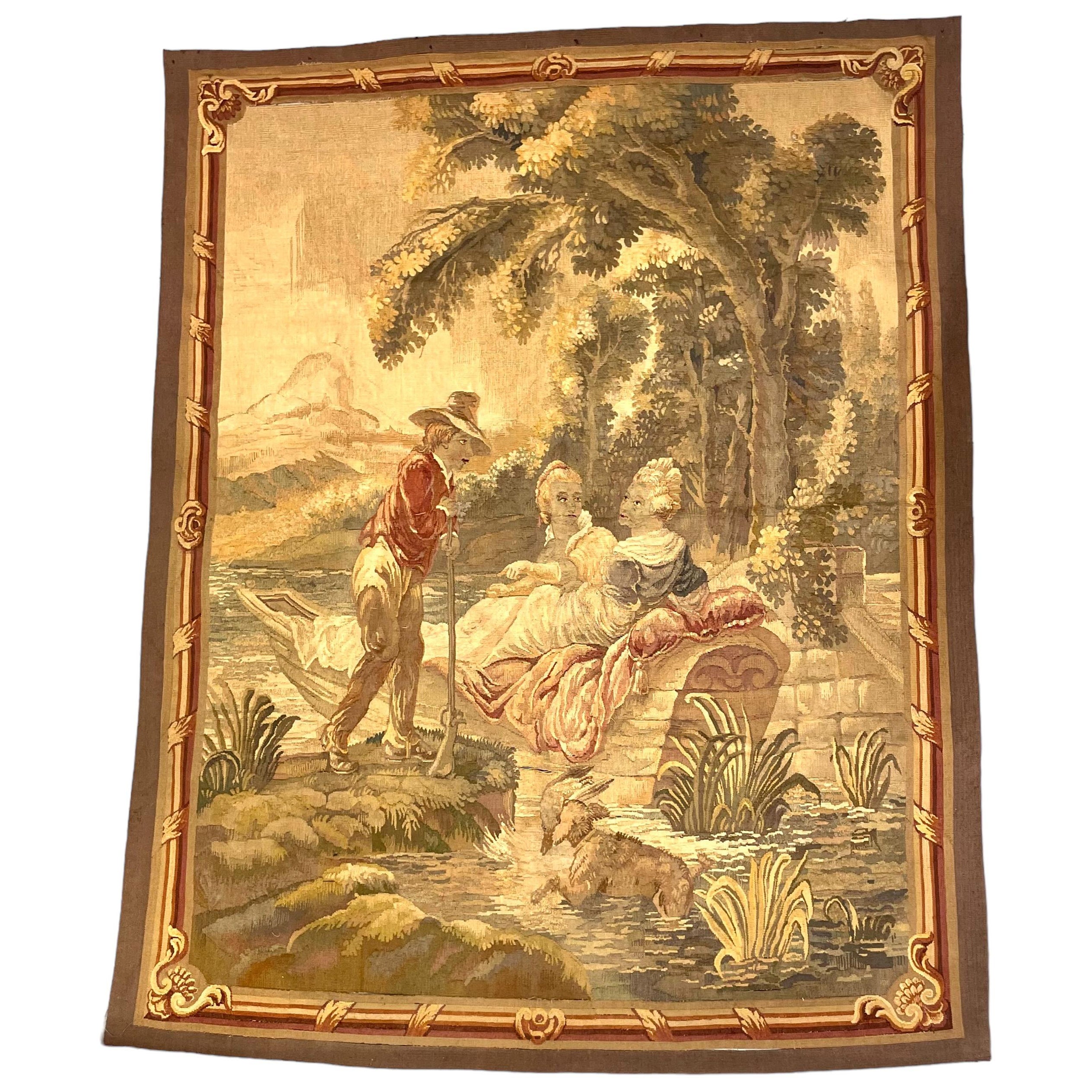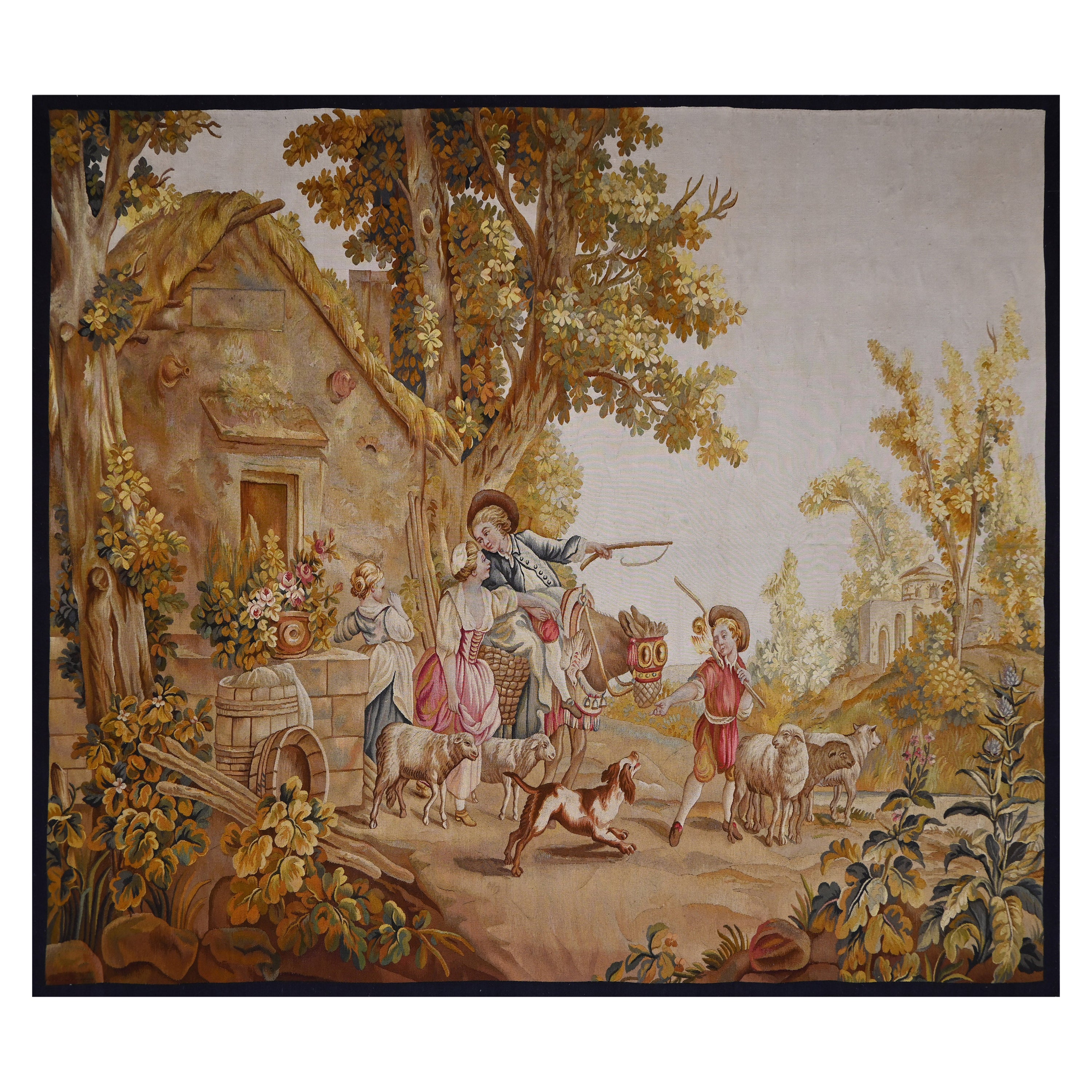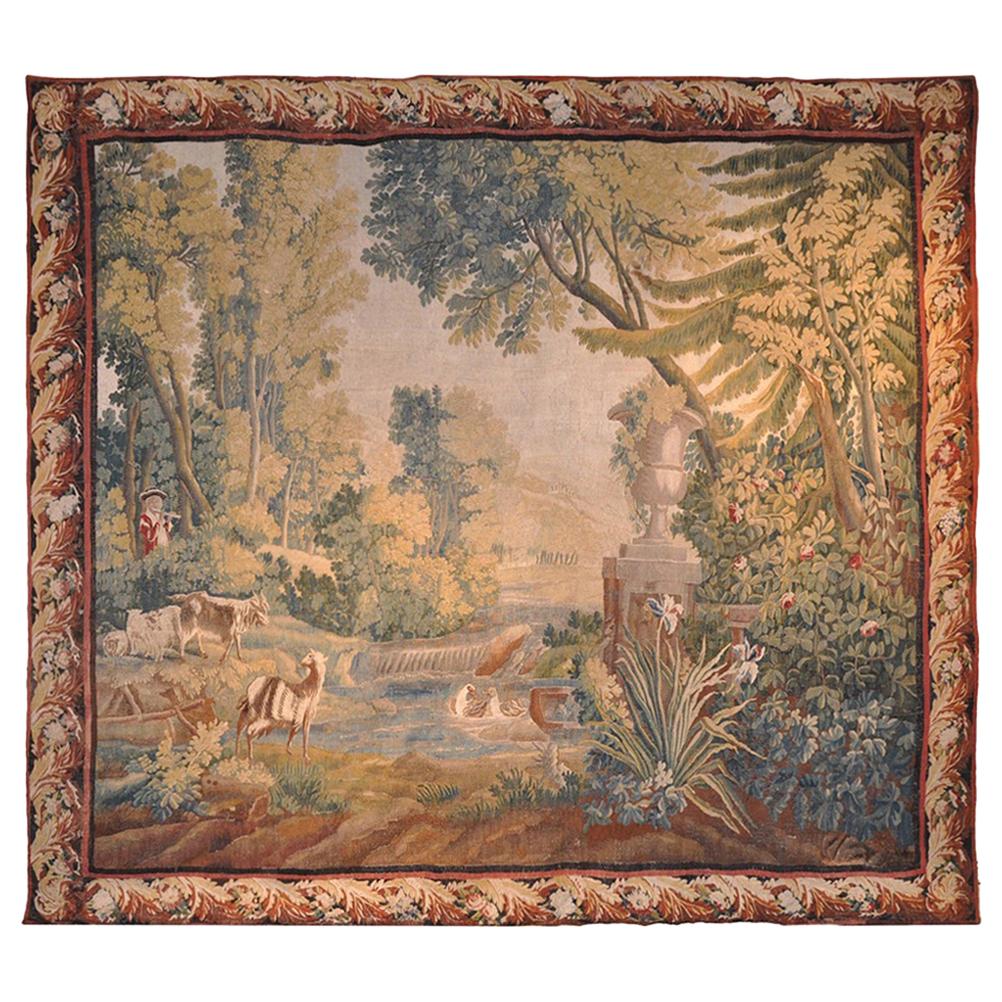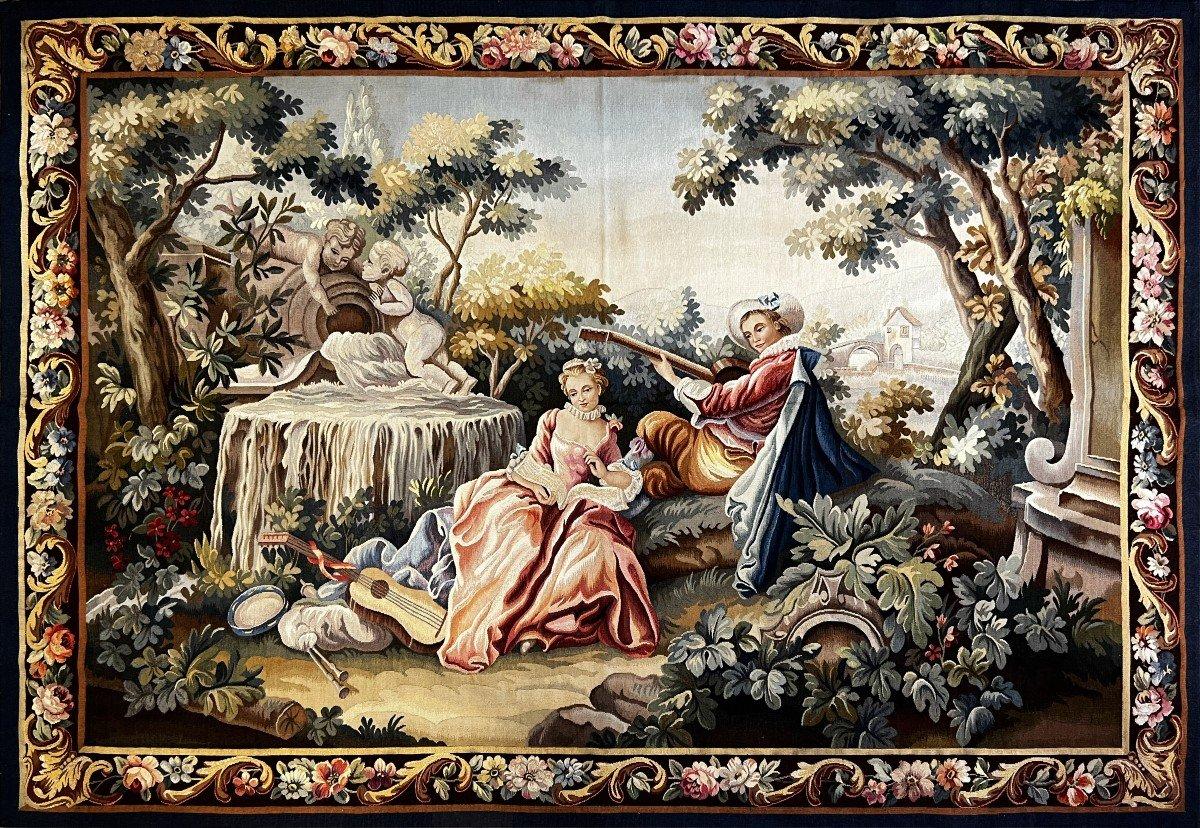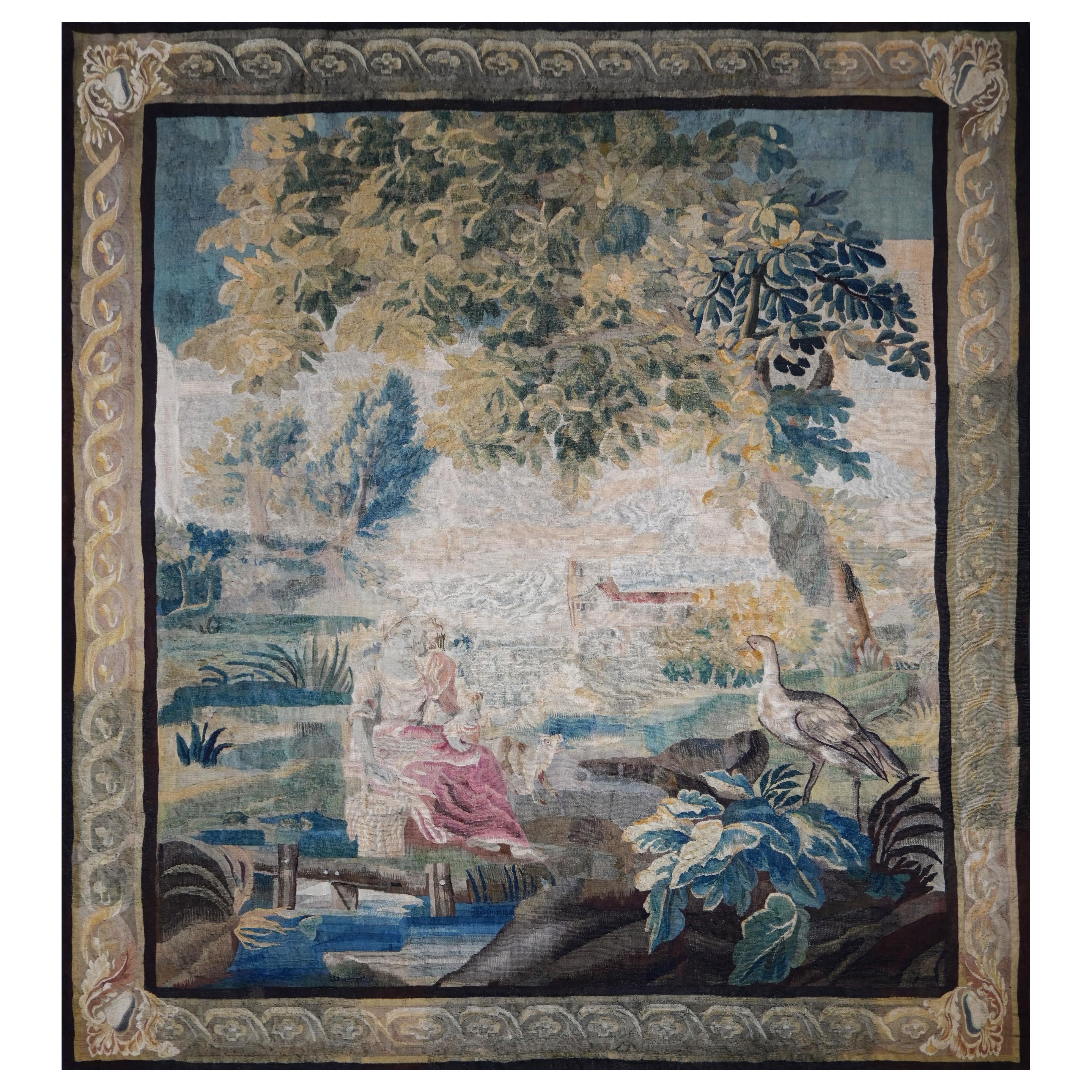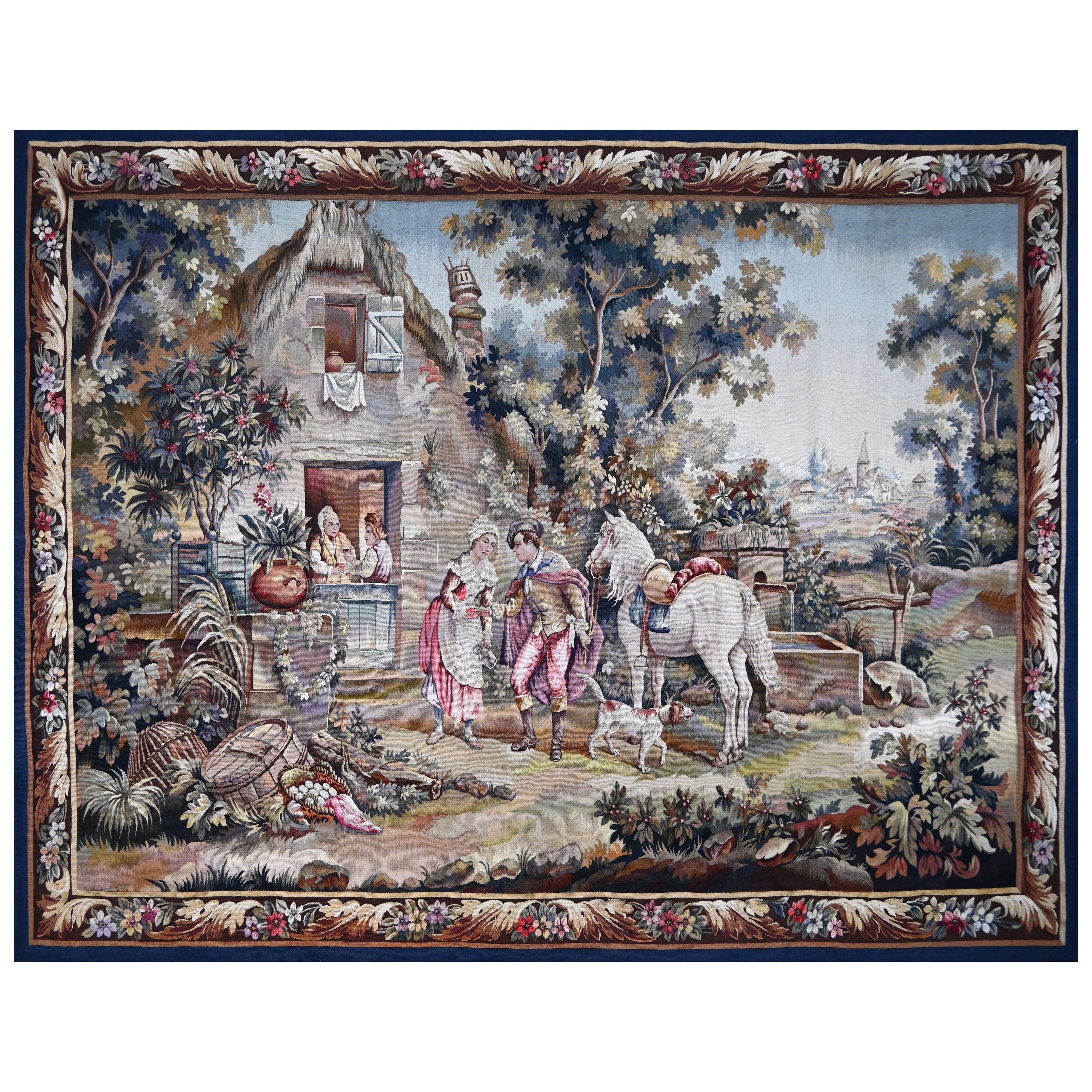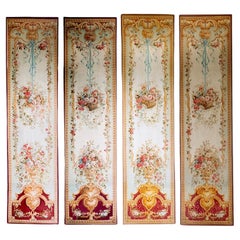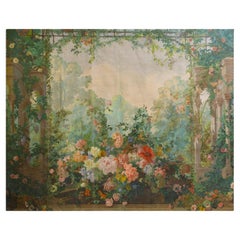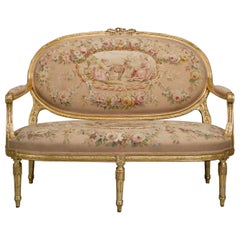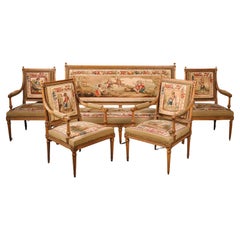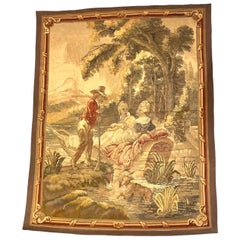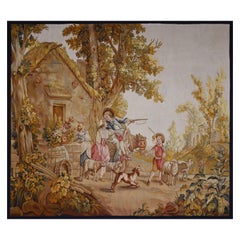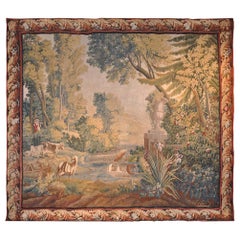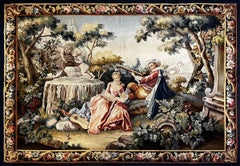Items Similar to Aubusson Tapestry Depicting a Pastoral Scene, French, circa 1900
Want more images or videos?
Request additional images or videos from the seller
1 of 10
Aubusson Tapestry Depicting a Pastoral Scene, French, circa 1900
$22,074.55
£16,000
€18,874.86
CA$30,363.21
A$33,750.59
CHF 17,691.34
MX$412,176.39
NOK 220,866.14
SEK 207,793.83
DKK 140,876.50
About the Item
An Aubusson tapestry depicting a pastoral scene.
The tapestry depicts a pastoral scene of a young couple fishing by the side of a stream with a bridge and rural buildings in the middle distance.
Aubusson
The small town of Aubusson, on the River Creuse in France, has a long history of producing elaborate and costly tapestries, famous throughout the world. Its origins were born with the arrival of weavers from Flanders, who took refuge in Aubusson, circa 1580.
Aubusson tapestries are known for their elegance and delicate coloring, often depicting romantic pastoral scenes derived from artists such as Boucher; historic scenes inspired by classical mythology; or more formalized architectural vistas. Aubusson was particularly noted for its finely balanced compositions of garlands and bouquets which became famous and sought after throughout Europe.
Louis XIV was instrumental in the development of the French tapestry industry, He recognized that by taking over the leadership of tapestry art from the Flemish, France could project its power and its culture worldwide, as well as increase its wealth.
In the 1662 the tapestry workshop of the Gobelins was proclaimed a “Manufacture Royale,” followed by Beauvais and Savonnerie. Originally these factories wove to furnish the royal palace at Versailles exclusively.
The weavers of Aubusson were granted this title of 'Manufacture Royale' a couple of years later in 1665, recognizing their place alongside these other leading tapestry makers. And at a time when the other Royal French tapestry producers could not supply outdside the Royal Court Aubusson flourished amongst the aristocracy and upper classes of Europe. Their output has always been considered to be the finest in the world.
Louis the XV, Louis the XVI and Napoleon I later all commissioned work from Aubusson. The latter two ordering in the greatest quantities. A 1786 inventory lists more than one hundred Aubusson carpets at the palace of Versailles and a 1789 inventory of all royal palaces describes a great many more.
A downturn in fortunes came after the French revolution and the arrival of wallpaper. However, tapestry made something of a comeback during the 1930s, with artists such as Cocteau, Dufy, Dali, Braque, Calder and Picasso being invited to Aubusson to express themselves through the medium of wool.
French, circa 1900.
- Creator:Aubusson Manufacture (Maker)
- Dimensions:Height: 63 in (160 cm)Width: 79.14 in (201 cm)Depth: 0.4 in (1 cm)
- Style:Louis XV (In the Style Of)
- Materials and Techniques:
- Place of Origin:
- Period:
- Date of Manufacture:circa 1900
- Condition:Wear consistent with age and use.
- Seller Location:Brighton, GB
- Reference Number:Seller: B664841stDibs: LU1028017991232
About the Seller
5.0
Recognized Seller
These prestigious sellers are industry leaders and represent the highest echelon for item quality and design.
Established in 1964
1stDibs seller since 2014
58 sales on 1stDibs
Typical response time: 6 hours
Associations
The British Antique Dealers' AssociationLAPADA - The Association of Arts & Antiques Dealers
- ShippingRetrieving quote...Shipping from: Brighton, United Kingdom
- Return Policy
Authenticity Guarantee
In the unlikely event there’s an issue with an item’s authenticity, contact us within 1 year for a full refund. DetailsMoney-Back Guarantee
If your item is not as described, is damaged in transit, or does not arrive, contact us within 7 days for a full refund. Details24-Hour Cancellation
You have a 24-hour grace period in which to reconsider your purchase, with no questions asked.Vetted Professional Sellers
Our world-class sellers must adhere to strict standards for service and quality, maintaining the integrity of our listings.Price-Match Guarantee
If you find that a seller listed the same item for a lower price elsewhere, we’ll match it.Trusted Global Delivery
Our best-in-class carrier network provides specialized shipping options worldwide, including custom delivery.More From This Seller
View AllA Set of Four Massive Aubusson Tapestry Entre-Fenêtres
By Aubusson Manufacture
Located in Brighton, West Sussex
A Fine Set of Four Massive Aubusson Tapestry Entre-fenêtres.
Comprising a true pair and two further panels en suite. Each woven in wools. The design of each with top cartouche issui...
Category
Antique 19th Century French Louis XV Tapestries
Materials
Tapestry
'Le Jardin d'Armide' - A Rare Wallpaper Panel by Desfossé
Located in Brighton, West Sussex
'Le Jardin d'Armide' (‘The Garden of Armida’)
A Rare Wallpaper Panel Designed By Édouard Muller (1823 - 1876) and Manufactured By Jules Desfossé.
Woodblock hand printed and polychr...
Category
Antique 19th Century French Belle Époque Wallpaper
Materials
Canvas, Paper
Louis XVI Style Canapé Upholstered with Aubusson Tapestry, circa 1880
By Aubusson Manufacture
Located in Brighton, West Sussex
A Louis XVI style Canapé, upholstered with Aubusson tapestry depicting a scene from Aesop’s Fables.
French, circa 1880.
The small town of Aubusson, on the River Creuse in France, had a long history of producing elaborate and costly tapestries. They were known for their elegance and delicate colouring and often depicted romantic pastoral scenes derived from artists such as Boucher; historic scenes, inspired by classical mythology; or more formalized architectural vistas.
Aubusson was particularly noted for its finely balanced compositions of garlands and bouquets which became famous and sought after throughout Europe.
Aesop was by tradition a labourer who was a contemporary of Croesus and Peisistratus in the mid-sixth century BC in Ancient Greece. The various collections that go under the rubric "Aesop's Fables" are still taught as moral lessons and for centuries have been influential subject matter for artistic endeavour.
The Shepherd Boy and the Wolf:
In a village was a young boy who had a job watching the village's sheep. Two times he called out, "Wolf! Wolf!" Each time the villagers came running to help the boy. And both times the boy just laughed at the villagers and called them names. But then the wolf really did come and start eating the sheep. The boy called, "Wolf! Wolf!" but the villagers just ignored his calls. They thought he was just trying to trick them again. The wolf took his time and had a huge meal of the entire flock of sheep.
The Wolf in Sheep's Clothing:
Once upon a time there was a wolf who decided to disguise himself so he could get some food without working too hard. He took a sheep's skin and hung it over his body. Then he went into the sheep pasture and pretended to graze with the sheep. He fooled everyone. Even the shepherd didn't realize she had a wolf grazing with her sheep. Soon the shepherd moved the sheep into the barn and the wolf went with them. The barn door was closed and locked and the wolf was just about ready to have a nice meal when the shepherd came back. She decided she wanted some food for her meal. She grabbed the wolf who was still disguised as a sheep and killed him for her meal.
The Wolf and the Crane:
One day a wolf had a bone stuck in his throat. He called to a crane and hired him for a large sum of money to put her head in his mouth and remove the bone. The crane did as she was hired to do and got the bone out and then asked to be paid. The wolf just grinned and said, "Ha! You've already been paid. I let you take your head safely out of my mouth when I could have crushed you with my powerful jaws”.
The Wolf and a Mountain Goat:
One day a wolf looked up and saw a mountain goat eating on a ledge high up on the side of a steep mountain. The wolf called out to the goat, "You should come down here to eat, you might fall if you stay up there. And the grass is very tender down here." But the mountain goat was too smart for the wolf and called back, "I don't think you are worried about my dinner. You are just looking for your own food!"
The Wolf and the Lamb...
Category
Antique Late 19th Century French Louis XVI Canapes
Materials
Tapestry, Giltwood
Louis XVI Style Beechwood and Aubusson Tapestry Five-Piece Salon Suite
Located in Brighton, West Sussex
A Louis XVI Style Beechwood and Aubusson Tapestry Five-piece Salon Suite.
Comprising a canapé and four fauteuils, the beechwood frames crisply carved with beading, stylised petals a...
Category
Antique 19th Century French Louis XVI Living Room Sets
Materials
Tapestry, Beech
A Louis XVI Style Giltwood and Aubusson Tapestry Five-Piece Salon Suite
Located in Brighton, West Sussex
A Louis XVI Style Giltwood and Aubusson Tapestry Five-Piece Salon Suite.
This suite of seat furniture comprises four fauteuils or open armchairs of generous proportions and a canapé...
Category
Antique 19th Century French Louis XVI Living Room Sets
Materials
Tapestry, Giltwood
Pair of Louis XVI Style Giltwood and Tapestry Fauteuils
Located in Brighton, West Sussex
A Pair of Louis XVI Style giltwood and tapestry fauteuils.
The tapestry 18th century and attributed to the Beauvais Manufactory. The frames are finely carved with guilloche bandin...
Category
Antique 19th Century French Louis XVI Armchairs
Materials
Tapestry, Giltwood
You May Also Like
French Aubusson Pastoral Tapestry featuring a Gallant Scene, Late 19th Century
By Aubusson Manufacture
Located in LA CIOTAT, FR
A fine and exuberant late 19th century Aubusson tapestry, depicting a gallant scene in a pastoral setting. Two maidens recline in a small boat on a river, against a background of tre...
Category
Antique 19th Century French Tapestries
Materials
Wool, Silk
French Aubusson tapestry , rural scene - No. 1344
By Aubusson Manufacture
Located in Paris, FR
Since 1991, a stone's throw from the Eiffel Tower, we have been a family business specializing in the Purchase, Sale, Traditional Cleaning, Restoration - Conservation, Expertise - Es...
Category
Antique 1840s French Aubusson Tapestries
Materials
Wool, Silk
18th Century French Handwoven Pastoral Verdure Aubusson Tapestry
By Aubusson Manufacture
Located in Dallas, TX
This large and elegant antique tapestry was crafted in Aubusson, France, circa 1760. The colorful wall piece features a country garden scene with goats, architectural elements and a ...
Category
Antique Mid-18th Century French Louis XVI Tapestries
Materials
Tapestry
19th Century Tapestry Gallant Scene - N° 1115
Located in Paris, FR
1115 - Tapisserie 19ème siècle scene galante avec des tres jolie couleurs.
Category
Antique 1850s French Aubusson Tapestries
Materials
Wool
French Aubusson Tapestry 18th century, Gallant Scene - 185lx220hcm - No 1538
By Aubusson Manufacture
Located in Paris, FR
Period: 18th century
Style: Romance
Condition: Perfect condition
Material: Wool and silk
Width: 185 cm
Height: 220 cm
Depth: 1 cm
In keeping with tradition, this magnificent tapestr...
Category
Antique 18th Century French French Provincial Tapestries
Materials
Wool, Silk
Gallant Scene, French Tapestry by Aubusson Manufactury 19th century - N° 1545
By Aubusson Manufacture
Located in Paris, FR
Period: 19th century
Style: Romance
Condition: Perfect
Material: Wool & Silk
Width: 216 cm
Height: 157 cm
Depth: 0.5 cm
In keeping with tradition, this magnificent tapestry has unde...
Category
Antique 19th Century French French Provincial Tapestries
Materials
Wool, Silk
More Ways To Browse
French Pastoral
Louis Xv Aubusson
Louis Xvi Aubusson Furniture
Louis Xv Beauvais Tapestry
Calder Tapestry Wall
Brussels Tapestry 18th Century
Flemish Tapestries Birds
Macrame Tapestry
18th Century Aubusson Verdure Tapestry
Deer Tapestry
Hunt Tapestry
Tapestry With Cherubs
4 X 5 Tapestries
Antique Embroidered Picture
Flemish Blue Tapestry
Macrame Hanging
14th Century Tapestry
Medieval Angel
